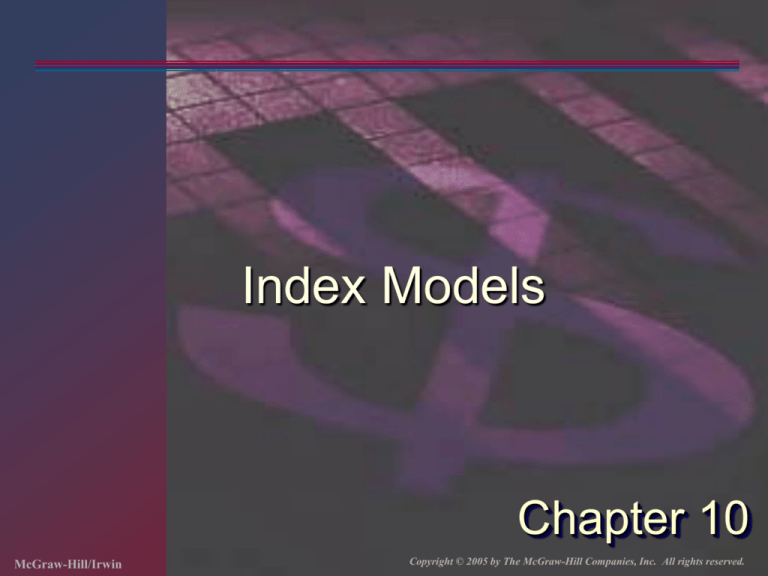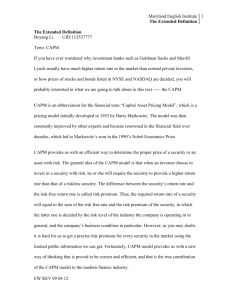
Index Models
Chapter 10
McGraw-Hill/Irwin
Copyright © 2005 by The McGraw-Hill Companies, Inc. All rights reserved.
A Single-Index Security Models
From a practical point of view Markowitz
model has two shortcomings
1. Problem: Computational complexity: In
Markowitz Model we estimate the exp.
Returns and covariance matrix.
Suppose we analyze 50 stocks. Our input
list;
N=50 estimate of expected returns
N=50 estimates of variances
(N2-N)/2= 1125 estimates of covariances
Total 1325 estimates
10-2
2. Problem: Model assumes that all the
risk and return characteristics can be
explained by the covariance of the
return with that of the other securities.
Changes in the non-financial factors
such as the growth rate of the economy
or the inflation rate are not accounted
for directly.
10-3
These considerations have led to various simplications and
extentions of the model. One simlication is by Sharpe (1963),
who developed the Single-Index Model.
This model imposes restrictions on how security returns can
covary. In particular, it is assumed that all covariance arises
through an index. This leads to a reduction in complexity.
Sharpe’s model has since been extended to multi-index models,
and leads to a more general theory called the Arbitrage Pricing
Theory, developed by Ross (1976).
Besides simplifying the covariance matrix, this approach is
easily to take account of non-financial factors. In the multi-index
models for example one of the indexes could be tha rate of
inflation.
10-4
A Single-Index Security Models
Suppose that we summarize all relevant
economic factors by one macro
economic indicator and assume that it
moves the security market as a whole.
We further assume that all remaining
uncertainity in stock returns is firmspecific.
10-5
A Single-Index Security Models
Return on stock i;
ri = E(ri)+mi +ei
mi:impact of unanticipated macro events on security
returns.
ei:impact of unanticipated firm-specific events.
Both have zero expected values because each
represent the impact of unanticipated events and
must average out to zero.
10-6
A Single-Index Security Models
Different firms have different
sensitivities to macro economic events.
If we denote the unanticipated
component of the macro factor by F, the
responsiveness of security i to
macroevents by beta, ßi, then macro
component of the security is mi = ßiF
10-7
Single Factor Model
ri = E(Ri) + ßiF + ei
ßi = index of a securities’ particular return to
the factor
F= some macro factor; in this case F is
unanticipated movement; F is commonly related
to security returns.
The variability of all stock returns can be
completely described by one common index plus
firm-specific events. Individual responsiveness to
the index is captured by the weight ßi.
10-8
The major assumption of Sharpe's singleindex model is that all the covariation of
security returns can be explained by a single
factor. This factor is called the index, hence
the name "single-index model." One version
of the model, called the market model, uses
a market index such as the S&P500 as the
factor, although in principle, any factor that
influences security returns can serve as the
index. Here, we will adopt the terminology
associated with the market model.
10-9
The second assumption of the single-index
model is that the ei (firm specific factors) are
independent across firms. This means that
the covariance of ei and ej is zero, and is
based on the assumption that the part of the
return that is not explained by the index
results from purely firm-specific events.
This independence leads to a significant
simplification of the covariance matrix of
returns.
10-10
Single Index Model
According to the index model, we can
seperate the actual (realized) rate of
return on a security into macro
(systematic) and micro (firm-specific)
components.
10-11
Single Index Model
Holding period excess return on the stock:
(ri - rf) =
Risk Prem
a i + ßi(rm - rf) + ei
Market Risk Prem
or Index Risk Prem
ai = the stock’s expected return if the
market’s excess return is zero
(rm - rf) = 0
ßi(rm - rf) = the component of return due to
movements in the market index
ei = firm specific component, not due to market
movements
10-12
Risk Premium Format
If we denote excess returns over the risk-free rate by capital R
Let: Ri = (ri - rf)
Rm = (rm - rf)
Risk premium
format
Ri = ai + ßi(Rm) + ei
10-13
Security Characteristic Line
Excess Returns (i)
SCL
.
.
.
.
.
.
. . .
..
.
.
.
.
.
.
.
.
.
.
.
. .
.
.
.
Excess returns
.
.
.
.
.
.
.
on market index
.
.
.
.
.
.
.
. .
.
.
.
.
.
.
..
Ri = a i + ßiRm + ei
10-14
Using the Text Example from Table 10-1
Jan.
Feb.
.
.
Dec
Mean
Std Dev
Excess
GM Ret.
5.41
-3.44
.
.
2.43
-.60
4.97
Excess
Mkt. Ret.
7.24
.93
.
.
3.90
1.75
3.32
10-15
Regression Results
rGM - rf = a + ß(rm - rf)
a
Estimated coefficient
-2.590
Std error of estimate
(1.547)
Variance of residuals = 12.601
Std dev of residuals = 3.550
R-SQR = 0.575
ß
1.1357
(0.309)
10-16
Components of Risk
Market or systematic risk: risk related to
the macro economic factor or market
index.
Unsystematic or firm specific risk: risk
not related to the macro factor or market
index.
Total risk = Systematic + Unsystematic
10-17
Measuring Components of Risk
We can break the variance of the rate of
return on each stock into components:
i2 = i2 m2 + 2(ei)
where;
i2 = total variance
i2 m2 = systematic variance
2(ei) = unsystematic variance
10-18
Examining Percentage of Variance
Total Risk = Systematic Risk +
Unsystematic Risk
Systematic Risk/Total Risk = 2
ßi2 m2 / 2 = 2
i2 m2 / i2 m2 + 2(ei) = 2
10-19
Single Index Model
Input list for single index model:
N estimates of E(Ri), expected excess returns.
N estimates of ßi, sensitivity coefficients.
N estimates of 2(ei), firm specific variances.
1 estimate m2 , variance of macro-economic
factor.
3n +1
Suppose we have 50 securities;
3x50 + 1= 151 estimates.
It is easy to use the single index model.
10-20
Advantages of the Single Index Model
Reduces the number of inputs for
diversification.
Easier for security analysts to
specialize.
10-21
Index Model and Diversification
As the number of stocks in the portfolio
rises, the unsystematic risk can be
diversified away. The market risk
remains.
Excess rate of return on the equally
weighted portfolio. wi=1/n
10-22
Index Model and Diversification
RP a P P eP
N
P 1 N i
i 1
N
a P 1 N ai
i 1
eP 1
2
p
N
N
e
i 1
i
2
P2 M
2 ( eP )
10-23
Index Model and Diversification
Because these ei s are independent and
all have zero expected value, as more
and more stocks are added to the
portfolio, the firm-specific components
tend to be cancel out.
When n gets large, 2(ep) becomes
negligible.
10-24
Risk Reduction with Diversification
St. Deviation
Unique Risk
2(eP)=2(e) / n
P2M2
Market Risk
Number of
Securities
10-25
The CAPM and the Index Model
Actual Returns vs Expected Returns
CAPM is a statement about ex ante or expected
returns whereas all we can observe are actual or
realized holding period returns.
To make a leap from expected to realized returns,
we can employ the index model.
The index model beta turns out to be the same
beta of CAPM expected return-beta relationship,
except we place an observable market index
instead of the theoretical market portfolio.
10-26
The CAPM and the Index Model
The Index model and the expected
return-beta relationship.
CAPM:
E(ri)-rf= ßi[E(rm)- rf]
If the index M is the true market portfolio,
we can take the expectation of each side of
the equation Ri = αi + ßi(Rm) + ei.
E(ri)-rf= αi +ßi[E(rm)- rf]
10-27
The CAPM and the Index Model
If we compare it with CAPM equation the only
difference is αi. CAPM predicts that αi should
be zero for all assets. The alpha of a stock is
expected return in excess of the fair expected
return as predicted by CAPM. If the stock is
fairly priced, its alpha must be zero.
If we estimate the index model for several
firms, using regression equation, we should
find expost (realized) alphas average will be
zero.
10-28
The CAPM and the Index Model
CAPM states that the expected value of
alpha is zero for all securities.
Index model states that realized value
of alpha should average zero.
Jensen examine the alphas realized by
mutual funds and found that frequency
distribution of these alphas seem to be
distributed around zero.
10-29






